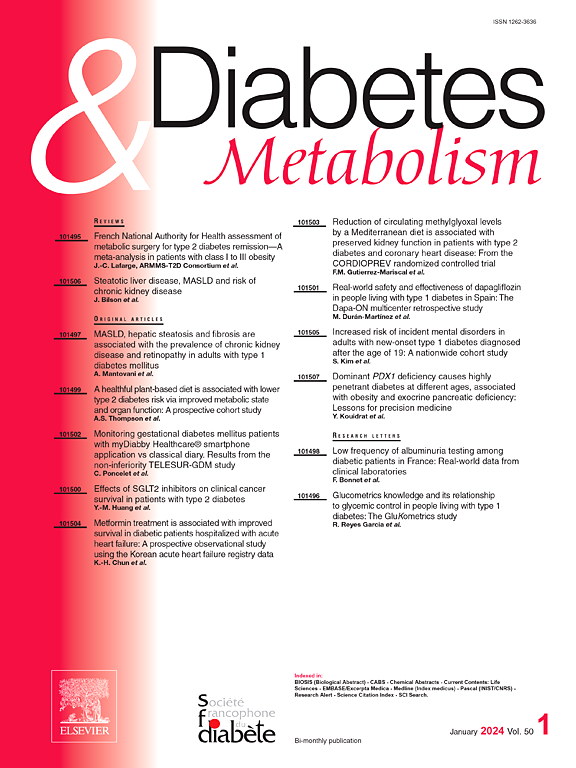Body weight trends in individuals with type 1 diabetes using automated insulin delivery vs. traditional insulin pumps
IF 4.7
2区 医学
Q1 ENDOCRINOLOGY & METABOLISM
引用次数: 0
Abstract
Objective
This study analyzed the determinants of weight gain among participants initiating an automated insulin delivery (AID) system.
Research design and methods
In this observational study, we evaluated 928 persons with type 1 diabetes initiating an insulin pump therapy, including 467 with AID, 98 with pumps with predictive low-glucose suspend (PLGS) algorithm and 363 initiating a sensor-augmented pump (SAP).
Results
After 3 months, median (95CI) TIR increased from 50.69 % [49.2–52.3] to 67.9 % [66.7–69.1] in the AID group and HbA1c levels showed a mean reduction of 0.82 %. AID resulted in equivalent body weight gain to SAP and PLGS despite significant improvements in glucose control. Multivariable analysis revealed that weight gain was linked to baseline HbA1C (P < 0.001) and age but not to the type of pump system. During follow-up, percentage increase in body weight at 12 months were similar between groups
Conclusions
In persons with T1D, AID did not increase weight gain in comparison to other pump systems.
1型糖尿病患者使用自动胰岛素输送与传统胰岛素泵的体重变化趋势
目的:本研究分析了启动自动胰岛素输送(AID)系统的参与者体重增加的决定因素。研究设计和方法:在这项观察性研究中,我们评估了928例开始胰岛素泵治疗的1型糖尿病患者,其中467例使用AID, 98例使用预测低糖悬浮(PLGS)算法的泵,363例使用传感器增强泵(SAP)。结果:3个月后,AID组的中位(95CI) TIR从50.69%[49.2-52.3]上升至67.9% [66.7-69.1],HbA1c水平平均下降0.82%。AID导致的体重增加与SAP和PLGS相当,尽管血糖控制有显著改善。多变量分析显示,体重增加与基线HbA1C有关
本文章由计算机程序翻译,如有差异,请以英文原文为准。
求助全文
约1分钟内获得全文
求助全文
来源期刊

Diabetes & metabolism
医学-内分泌学与代谢
CiteScore
12.00
自引率
4.20%
发文量
86
审稿时长
13 days
期刊介绍:
A high quality scientific journal with an international readership
Official publication of the SFD, Diabetes & Metabolism, publishes high-quality papers by leading teams, forming a close link between hospital and research units. Diabetes & Metabolism is published in English language and is indexed in all major databases with its impact factor constantly progressing.
Diabetes & Metabolism contains original articles, short reports and comprehensive reviews.
 求助内容:
求助内容: 应助结果提醒方式:
应助结果提醒方式:


